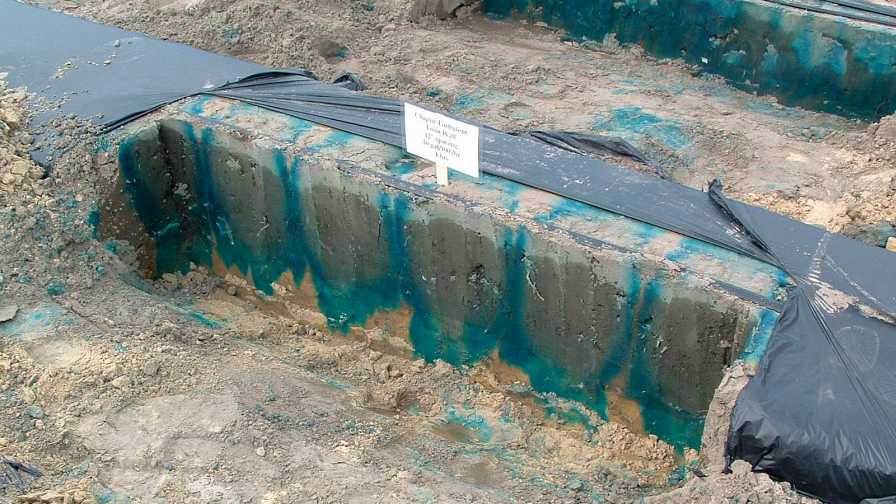How To Track Irrigation: Keep Your Eye On The Blue Dye

Where does the water run? Follow the blue dye as seen during this demonstration in a plastic mulched system.
Photo courtesy of UF/IFAS
Florida vegetable growers have adopted various drip irrigation methods as well as plastic and other mulching practices. Since soils in much of Florida are very sandy with low water holding capacity, UF/IFAS recommendations for irrigation management for fruit and vegetable crops include using a combination of targeted irrigation volume, a measure of soil moisture to adjust this volume based on crop age and weather conditions, a knowledge of how much water the root zone can hold and an assessment of how rainfall contributes to replenishing soil moisture.
UF/IFAS County Extension agents and state specialists have been working with Suwannee Valley’s vegetable growers who use plastic mulch and drip irrigation for refining their management of the technology since it was introduced to the region in the late 1980s. Starting in the Suwannee Valley area with plastic mulch and drip-irrigated vegetables, this effort expanded in 2015 to include blueberry farms.
Perhaps the most popular demonstration being taught by Extension at Florida drip irrigation schools and on farm demonstrations is the use of blue dye injected into the irrigation system to see how quickly the water moves downward through the soil profile. Since research on this technique began at the Suwannee Valley Agricultural Extension Center near Live Oak in 2001, it has been demonstrated on dozens of farms.
Blue Light Special
The blue dye (agricultural spray indicator dye) is used to visualize the wetting pattern of the soil profile under the drip tape or other emitter types. After injection of the blue dye, growers followed their normal irrigation schedules and then a cross section of the soil profile was dug to measure how far the water and nutrients move. It was common for growers to make immediate changes in irrigation schedules based on what they observed. Growers and Extension agents began to coin the phrase, “The blue dye don’t lie,” showing the undeniable lessons learned in watching the results of the blue dye demonstrations.
Although much of the early blue dye work was done in vegetable crops, interest in the technique among blueberry growers resulted in the recent addition of blueberry demonstrations. Blueberry has become an important crop in Florida, expanding from around 1,000 to more than 7,000 acres of production in the last 15 years.
Since most Florida soils do not meet the pH or organic content requirements for optimum blueberry yields, the crop is typically planted in amended soil. Pine bark is the amendment often chosen by growers. It is typically either windrowed into 8- to 14-inch-high beds spaced 8 to 10 feet apart (“straight pine bark culture”) or incorporated into the soil forming the bed (“incorporated pine bark culture”).
Each of these planting systems have their pros and cons. Once established, blueberry plants grow rapidly in straight pine bark, at times producing a commercial crop in the first year. Attaining sufficient initial moisture in pine bark beds can be difficult due to its hydrophobic nature and also there is a tendency for water to channel down through the roots zone instead of moving laterally in the bed.
Recently, the increased cost and inconsistent availability of pine bark has been a factor in many new fields being established with incorporated pine bark. Less pine bark is required in an incorporated bark system, and growers mention that irrigation management is somewhat easier. The main disadvantage is that weed management, especially with perennials such as nutsedge, is more challenging.
No matter the production system, an efficient irrigation scheduling plan is necessary to have good production without wasting water, a precious natural resource.

With the help of blue dye, this demonstration shows water movement in an eight-month-old straight pine bark field after 13 minutes of irrigation cycle.
Photo courtesy of UF/IFAS
Irrigation Implementation
UF/IFAS Extension Blueberry Specialist, Dr. Jeff Williamson has done some long-term studies for determining how much water a blueberry plant uses during different times of the year. This information, along with knowing the length of time an irrigation cycle can run to wet the root zone but not push the water any deeper, is helpful in developing an irrigation scheduling program.
In late 2015, demonstrations were conducted in straight and incorporated bark fields in Florida and one incorporated bark field in South Georgia with the help of John Ed Smith of Michigan Blueberry Growers (Naturipe). Results indicated that drip irrigation pushed water below the root zone in eight minutes in an eight-month-old straight pine bark planting in Central Florida. In a seven-year-old planting on the same farm, drip irrigation pushed water below the rootzone in more than eight, but less than 12 minutes.
The demonstration in incorporated bark was surprising, as blue dye was pushed below the blueberry rootzone in eight to 12 minutes by drip irrigation in a Central Florida farm and in only 30 minutes with overhead irrigation. In South Georgia, it took around 28 minutes to push blue dye below the rootzone with drip irrigation due to the apparent higher water-holding capacity of its soils.
In these demonstrations, everyone learns that blue dye technology is a good way to monitor water movement through blueberry soils. Due to the probability of variation between different contents of soils, irrigation systems, and other factors, it is necessary to evaluate each farm and possibly multiple locations within a farm to get a good picture of the dynamics of water moving through the rootzone.









